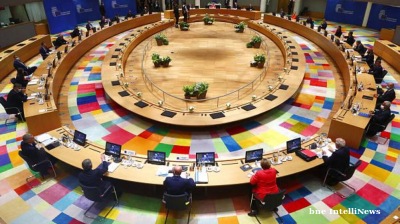The accession of Finland and Sweden to Nato will transform the strategic position of Latvia, Lithuania and Estonia, but the Baltic states still need futher reinforcement to deter Russian aggression, argue Baltic defence ministries and experts.
“Finland and Sweden joining Nato would very clearly strengthen Baltic security as well as Nato security as a whole,” Estonia’s defence ministry told bne IntelliNews.
“It would strengthen the Nato naval dimension and increase the allied naval presence in the Baltic Sea, thereby enhancing deterrence and defence in the entire region,” a Lithuanian defence ministry spokesman emphasised.
Finland and Sweden, both previously non-aligned, have rethought their strategic position, given the way Ukraine was picked off by Russia because it was not a member of the Western defence alliance. Both countries have also rushed to send materiel to bolster Ukraine’s defences.
On May 16 Finland’s parliament approved its Nato application and Sweden’s government agreed to move forward with its approach to Nato. It is expected that a formal joint approach to Nato will be made during Finnish President Sauli Niinisto’s official visit to Stockholm on May 17-18 this week.
Accession requires unanimity from the existing 30 member states, which is expected to be finalised later this year. Although Turkish President Recep Tayyip Erdogan has said he is opposed to the entry of the Nordic states – because they allow Kurdish rebel movements to operate legally in their countries – Turkey is not expected to veto their accession.
Exceptionally close co-operation
Both Finland and Sweden have already been closely integrated with Nato, partly through the Joint Expeditionary Force – a Nordic and Baltic security force, together with the UK and The Netherlands – as well as regular interoperability exercises.
They also already share many security interests with the Baltic states, notably regarding Russian naval and air incursions in the Baltic Sea area.
The Lithuanian defence ministry said the Balts and Nordic states have developed close and enduring co-operation in many areas, including security and defence. “Our co-operation is exceptionally close, the Nato membership would elevate it to another level of co-operation,” the spokesman underlined.
An official at the Estonian Ministry of Defence told bne IntelliNews that Finland and Sweden are “already key defence co-operation partners” for Estonia in the Baltic region. “But these countries joining Nato would take that co-operation to another, much higher and allied level,” he underscored.
In particular, the two Nordic states would significantly bolster Nato’s sea and air defence forces in and over the Baltic Sea, which would now become a “Nato lake” surrounded by members of the Western military alliance. Among other things, this should mean that the Baltic states could be more easily reinforced by sea in the event of a Russian invasion.
This would partly offset the Baltic states’ weakened strategic position since Russia’s aggression against Ukraine, together with its creeping takeover of Belarus. Belarus’ role as a launchpad for the invasion of Ukraine means that Russia’s border has effectively moved up to the Belarus frontier, endangering Lithuania and Poland, which are contiguous with Belarus.
The invasion also meant the three Baltic Nato member states were very vulnerable to being isolated from the rest of Nato. A Russian thrust from Belarus towards its Kaliningrad exclave on the Baltic Sea could quickly close off the 65-km Suwalki gap between Poland and the three former Soviet republics. This would make it very difficult for Nato to reinforce them and fulfil its Article 5 guarantee to defend its members.
Angry reaction
These risks have only been underlined by Russia’s angry reaction to Finland’s and Sweden’s decision to join Nato. The Kremlin described Finland’s move as “absolutely” a threat to Russia. Dmitry Peskov, President Vladimir Putin’s spokesman, told reporters that “expanding Nato yet again does not make our continent more stable and safe”, according to Interfax, the Russian news agency.
Putin told Niinisto last week that Finland is making a “mistake” by joining Nato, as it faces “no security threats”.
There are fears that – once free of its Ukraine entanglement – Russia could take military advantage of the interim period this year before Finland and Sweden receive the full protection of Nato’s collective defence agreement under Article 5.
Nato Secretary-General Jens Stoltenberg said at the Nato summit of foreign ministers in Berlin on Sunday that in this interim period, Nato would “look into ways to provide security assurances, including by increasing Nato’s presence in the Baltic region, in and around Finland and Sweden”.
Otto Tabuns, executive director of Baltic Security Foundation (BSF), an organisation promoting the security and defence of the Baltic Sea region, told bne IntelliNews that Finland and Sweden choosing to join Nato “could increase tensions with Russia”, but would “undoubtedly benefit” the Baltic states’ defence.
“It is in the Russian interest for Finland and Sweden to stay out of Nato, as that keeps Nato and EU from closer security co-operation and keeps separate the defence efforts of Sweden, Finland and the Nato members that share the Baltic Sea. Such a division had allowed Moscow's bilateral influence to matter more,” Tabuns underscored.
What is important for the Baltic states, he says, is that the Baltic Sea – likely to be contested in any potential conflict – would not be completely blocked for the purposes of reinforcement.
“Therefore the security of key points such as [the island of] Gotland and the energy and telecom infrastructure that crosses the Baltic Sea is crucial, and is reinforced when backed by a collective security arrangement. Russia may not be able to stop that by opening another front right now. But it is expected to further threaten the two states to delay a Nato decision until a moment when it is better able to stop it,” the BSF director pointed out.
Spectrum of capabilities
Once they eventually join, the two Nordic states are expected to benefit Baltic security in many different ways.
“Finland and Sweden's accession to Nato will allow [the enhancement of] our situational awareness on Russia's military posture and military activities in the region. As Nato members, Baltic and Nordic states would even more closely participate in Nato common activities such as exercises and co-ordinate national activities to deter Russia,” said the Lithuanian defence ministry.
Asked how the Balts and Nordics can co-operate more militarily in the Baltics in warding off Russian military threats, the spokesman pointed out that the two countries becoming part of Nato will mean “integrating command structures, joint planning and more closely aligned exercises – an essential part of military operations”.
“Situational awareness in the airspace and at sea will improve, and intelligence sharing will be further facilitated if Finland and Sweden join Nato,” the defence ministry official said.
A Lithuanian journalist specialising on defence issues told bne IntelliNews that Sweden and Finland’s Nato memberships would mean a “great deal” to the security of the Baltic states.
“Because it would enhance the spectrum of capabilities, the area of operations and, not just friendly but firmly allied nations bound by the security arrangements…of Article 5. It would also affect certain capabilities and operational planning by Russia if they had any hostile intentions towards the Baltic states,” he said.
When asked how the Baltic and Nordic states could work more closely on defence issues, he said: “ISTAR [linking sensors in intelligence, surveillance, target intelligence, surveillance, target acquisition and reconnaissance], maritime security and surveillance capabilities come to mind; also a dramatic increase of availability of friendly naval and air infrastructure in Sweden and Finland, in case of hostile activities. The island of Gotland, aka the unsinkable aircraft carrier, …would play an ever more important role in deterrence.”
Built from scratch
The Nordic states’ accession to Nato will come on top of the efforts that the Baltic states and the Western defence alliance are already making to boost defence in the region.
The Baltic states have built armed forces from scratch since they regained their independence in 1991. They have long been among the few Nato members that have devoted more than the recommended 2% of GDP to defence since they joined the alliance in 2004.
In the wake of the Russian invasion of Ukraine, Lithuania raised defence spending to 2.52% of GDP. The current budget allocates just over €1.2bn, or 2.05% of GDP, to the country’s defence.
Latvia has decided to increase spending to 2.5% by 2025, implying about €100mn ($111mn) in extra funding, which will be used for medium-range air defence systems, ground force mechanisation and cyber security, among other upgrades.
Meanwhile, Estonia, the smallest Baltic state, has said it will increase defence spending over the next four years to 2.5% of its GDP. Estonia's current defence spending is 2.3% of GDP.
Nato’s Western European members have recently moved more troops into the Baltic states, Poland and Romania to strengthen the pact’s deterrence against Russia and provide reassurance to the Eastern Flank states. It has also activated its 10,000-strong rapid response force for the first time.
The Enhanced Forward Presence battlegroups stationed in Poland and the three Baltic states since 2017, following Russia’s invasion of Crimea, are being doubled in size to more than 6,000 troops. These are part of the 40,000 troops on the Eastern Flank from Estonia to Bulgaria that are under direct Nato command – ten times the figure before the invasion – and the 330,000 total number of national troops in the eight Nato flank states.
More fighter jets have been sent to the region, particularly the Baltic states, which lack supersonic fighters of their own. Western air defence systems have also been deployed on the Eastern Flank, such as the UK’s Sky Sabre defence system, which is intended to create a “no cross air line” stretching for 240 km along Poland’s eastern border with Ukraine.
More secure than they have ever been
More is envisaged. According to the Nato summit declaration of March 24: “We will also significantly strengthen our longer-term deterrence and defence posture, and will further develop the full range of ready forces and capabilities necessary to maintain credible deterrence and defence."
“The Baltic states are being reinforced like they could hardly ever dream of in 2004, 2008 or even compared to 2014,” said the defence journalist. “A paradox, that even in dangerous and destabilising times such as these, when Russia has unleashed its true self, Baltic states are more secure now than they have ever been, given the increased investment in their own security as well as increasing allied support,” the analyst noted.
However, the Baltic governments are calling for even larger and more permanent forces to be stationed in their countries, including heavier offensive weapons such as tanks, fighter jets and air and sea defence systems. They want the multinational battle groups in each country to be boosted to brigades of 3,000-5,000 troops. They also want the air-policing missions to be upgraded to air defence, so they can shoot down Russian intruders in their airspace.
This would complete the transformation of the Nato forces in the region from just a tripwire into something that would contain Russia and potentially defend the countries in the event of a conflict until Nato forces from Western Europe could arrive.
“Russia has a military advantage in the region; in Kaliningrad it hosts huge offensive capabilities, including dual-capable missile systems, battle tanks, artillery systems. Russia's war against Ukraine showed that Russia can take military actions very quickly in the region if it decides so,” the Lithuanian defence ministry emphasises to bne IntelliNews.
He argues Nato should have more credible forward deployed forces in the region, underpinned by quick and viable reinforcement.
“Air defence is a particular importance. We invest in air defence; however, it won‘t be sufficient to protect national and allied forces in the conflict. We expect that air policing [will] be transitioned to air defence,” he points out.
The Estonian defence ministry says that the Russian war in Ukraine and its threats against Nato allies show that military aggression against Nato “cannot be ruled” out at this point.
“Therefore the current enhanced Forward Presence posture needs to transition to a Forward Defence posture. This means increasing the allied presence in the Baltic states, developing a divisional-level command structure in each Baltic state and ramping up activities in the air and maritime domains. The main aim is to deny Russia the ability to reach their goals by aggression,” the spokesman says.
“In addition to a Nato division command structure, we need stronger air defence and maritime posture. What’s most important is a clear command structure, clarity in the mobility of critical capabilities, and pre-positioned equipment.”
The good news for the Balts is that Nato now appears to be moving in this direction, with the June summit set to agree a new Eastern Flank defence strategy, one which not just involves Sweden and Finland, but which also makes Baltic defence central to the bloc’s thinking.
Features

The European Commission proposes to “creatively” tap Russia’s $300bn of frozen assets with Reparation Loans
The European Commission is floating a new idea of how to “creatively” tap Russia’s $300bn of frozen assets without the need to appropriate, which is legally questionable, by replacing the money transferred to Kyiv with EU-backed bonds.

“Yuri Gagarin” cosmodrome seeking a future in space – and tourism
Golden age of spaceport is long over, with Moscow focused on facilities in Russia. Kazakhstan, however, hopes it can find profitable niche in launching satellites.

Russia’s 13 “drowning men” sink into corporate debt – The Bell
The Central Bank of Russia has quietly acknowledged growing financial distress among the country’s largest companies, identifying 13 corporations as "truly problematic" borrowers at the end of the first quarter.

Iranian arrested for Kalashnikov shooting near Caspian Sea
Iranian authorities arrest driver who opened fire with Kalashnikov rifle during road dispute on busy Chalous highway connecting Tehran to Caspian coast.



